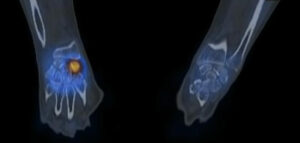
Home WRIST FRACTURES: COMMON INJURIES FROM A FALL
In Canada, many of us are wary of when the snow starts to fall and the ground gets icy, especially if you are one of the many people who have been injured in a fall. According to the Canadian Institute for Health Information, four out of five injury hospitalizations involving seniors were due to falls. From 2016-2019, injury hospitalizations among seniors due to falls increased by 9%.
Cold weather can also make muscles and ligaments cold and tight, increasing the propensity for injury in all age groups. One of the most common injuries occurs when you try to break your fall with your hands, often resulting in a wrist fracture.
The wrist is made up of eight small bones which connect with the two long forearm bones called the radius and ulna. Although a broken wrist can happen in any of these 10 bones, by far the most common bone to break is the radius – called a distal radius fracture. The scaphoid bone, one of the small wrist bones, can also be commonly fractured after such a fall. Bone diseases like osteoporosis can also increase the likelihood of a fracture.
With a distal radius fracture, there is often pain, swelling, or difficulty moving or using the hand and wrist. A bone out of place can make the wrist appear deformed and sometimes the fingers tingle or feel numb at the tips.
Symptoms of a scaphoid fracture typically include pain and tenderness in the area just below the base of the thumb, which may worsen when you try to pinch or grasp something. However, unless you or your doctor sees a visible deformation of your wrist, it might not be obvious that your scaphoid bone is broken. Sometimes, the pain is mild and may be mistaken for a wrist sprain.
Seeing a physician after such a fall is important in helping to avoid potential complications of a fracture, such as the bone not healing, disrupted blood supply to the bone, or development of early arthritis.
Depending on the type of fracture, wrist injuries can be treated with splints or casts. In more serious or complex breaks, surgery may be required to correctly position and stabilize damaged bones.
Treatment for a scaphoid fracture can range from casting to surgery, depending on the fracture’s severity and location in the bone. That’s why it’s important to accurately diagnose and localize the fracture.
Depending on your symptoms, your doctor may send you for an X-ray to determine if there are any fractured bones. Interestingly, scaphoid fractures cannot always be seen on X-rays immediately after the injury. If your doctor suspects that you have a fracture, but it’s not visible on an X-ray, he or she may recommend that you wear a wrist splint or cast for 2-3 weeks and then return for a follow-up X-ray. Alternatively, additional imaging, such as magnetic resonance imaging (MRI), computed tomography (CT) imaging, or a bone scan can be performed.

SPECT/CT image of scaphoid fracture
It’s important to speak to your health care practitioner about your options if you are experiencing pain in the wrist after a fall.
For more information about Mayfair Diagnostics, visit our locations or our services pages.
REFERENCES
Alberta Health Services (2022) “Preventing Falls.” www.albertahealthservices.ca. Accessed September 30, 2022.
Canadian Institute for Health Information (2019) “Slips, trips and falls: Our newest date reveals causes of injury hospitalization and ER visits in Canada.” www.cihi.ca. Accessed September 30, 2022.
Morhart, M. (2022) “Wrist Fractures and Dislocations.” www.emedicine.medscape.com. Accessed September 30, 2022.
Ye, J., et al. (2022) “Prevalence, Characteristics, and Associated Risk Factors of Wrist Fractures in Americans Above 50: The Cross-Sectional NHANES Study.” Frontiers in Endocrinology, 25 April 2022, Section: Bone Research. www.frontiersin.org.
We foster a supportive and collaborative culture designed to encourage positive patient experiences and build strong working relationships across the organization:
Our core values shape the way we work with patients, partners, and fellow employees. And, more than anything else, they’re what set Mayfair apart. In everything we do, this is what we strive for:
EXCELLENCE
We share a commitment to high quality and excellence in all that we do. This commitment calls on all of us to achieve the very best of our capabilities and exceed our own expectations.
CURIOSITY
We innovate in everything, from services to processes. We believe meaningful change and effective problem solving come only by looking at challenges and opportunities from new angles and by exercising our creativity and curiosity.
PASSION
We show pride, enthusiasm, and dedication in everything that we do. We are committed to producing and delivering high-quality results and services. We are passionate about our industry and about our company, services, partners, and patients.
COLLABORATION
Our team is supportive of each other’s efforts; we are loyal to one another; and we care for one another both personally and professionally. We promote and support a diverse, yet unified, team. We work together to meet our common goals across Mayfair clinics, locations, and geographies. Only through collaboration on ideas, technologies, and talents can we achieve our mission and vision.
SERVICE
We take pride in delivering exceptional service every day. We listen to every request with an open mind, always looking for opportunities to go above and beyond to create memorable, personalized experiences. We take responsibility to answer our referrers’ and patients’ requests and respect their time by always responding with a sense of urgency.
Start a career with Mayfair Diagnostics — one of Western Canada’s leading medical imaging teams.
Headquartered in Calgary, Alberta, we’ve been helping people f ind clarity for their health for over 100 years. At our clinics in Calgary and area, Regina, and Saskatoon, our team of radiologists, technologists, and support staff work in a truly integrated way to provide exceptional experiences for our patients. Joining our team is more than a job. It’s an investment in your future — a plan for success.
OUR PEOPLE
Our people share our quest to make a difference in our patient’s lives. We’re a team of professionals, disciplined in our skills and compassionate with our patients, providing the care and attention they need. At our core, we are a trusted partner in our patients’ health care journey. Our patients, physicians, and other health care providers rely on us for quality imaging to help manage their patient’s health care decisions with certainty. But our business is about more than just imaging. It’s about building lasting relationships and making a meaningful difference in the lives of those we meet.
OUR VISION
A world in which every person has clarity about their health. We push the boundaries of what is possible and embrace change as an opportunity. We strive to be thought leaders and encourage creativity by providing a safe place for calculated risk taking. We learn from our mistakes. We share best practices across our operations and are recognized by our peers for our work. We engage the best to help propel us forward in achieving our goals.